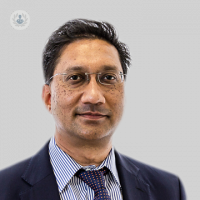What’s the difference between a chalazion and a stye?
Written in association with:Both chalazions and styes are quite commonly experienced. We spoke to leading ophthalmologist, Mr Jimmy Uddin, to find out what the fastest way is to get rid of these two conditions.

In this article, Mr Uddin explains how they can be prevented and what the difference is between a stye and a chalazion. He let us know why surgery is often needed for chalazions and gave information on what aftercare is needed for this procedure.
What is a chalazion and how is it different to a stye?
A chalazion is a small lump on the lower lid that’s usually been there for a number of weeks or months and it’s painless. A stye is an infection of the meibomian glands and it’s acute, usually painful and red, it either internal or external, it may protrude out of the lid or inside of the lid.
What is the fastest way to get rid of a chalazion?
Due to its chronic nature, it doesn’t respond well to tablets, a small surgical procedure can be performed and it has a 95% success rate. It takes roughly 20 minutes to half an hour and it can be done in one day.
How do you go about the surgery?
For styes, there are warm compresses. You basically get a warm towel and put it over the eyelid for a day. Sometimes antibiotics and anti-inflammatory drops can be used.
For chalazions, surgery can be performed with local anaesthetic. Once it’s administered, the area we operate on becomes totally numb and painless, the incision is usually made on your outer eyelid (for a larger chalazion) or the inner eyelid (for a smaller one).
Normally there’s no incision or scar on the skin unless the chalazion is pointing through the skin, then you have a pad over that eye for bruising and swelling and it mostly settles down within two to three days.
What aftercare is needed?
You can travel home if one eye is done, a pad may be applied over the eye and this is done a few hours after the procedure. The eye will be a bit bruised, however with ointments, after 2 days the swelling go back to normal, and there is a 95% success rate that it will be completely resolved.
When is surgery needed?
It’s not always needed unless the lump is interfering with your vision or you would like to remove it for cosmetic reasons. Also, if you are of an older age group or it’s a bit unusual, it’s reasonable to do the procedure and send the material of to ensure it isn’t a tumour - a biopsy would need to be done.
How can I prevent a chalazion or stye?
Skin types or people who are prone to acne or acne rosacea, stress or being run down can make you more prone to chalazion or styes. Warm compresses on the eyes can help, anti-inflammatories, eye drops, lubricants can help with comfort and medication such as doxycycline that reduces inflammation of the lids. It is also recommended to take Omega 3 whether by eating fish such as salmon, sardines, or in a pill form from health food stores.
For more information on treatment eye issues such as chalazions or styes, you may like to book an appointment with a leading ophthalmologist such as Mr Jimmy Uddin. Visit his Top Doctors profile today for more information.


